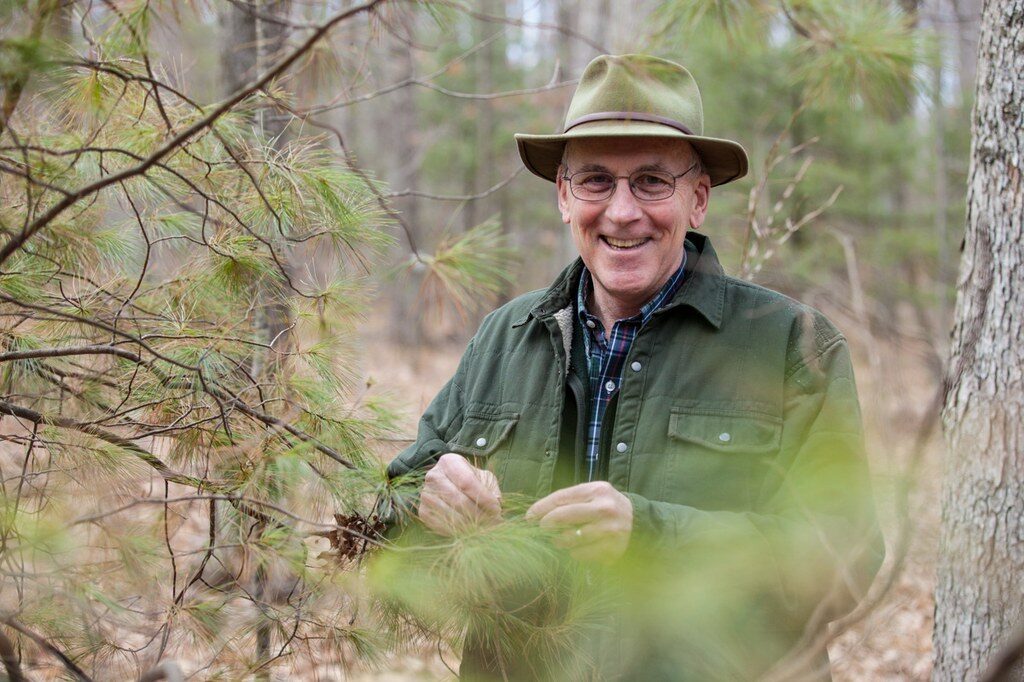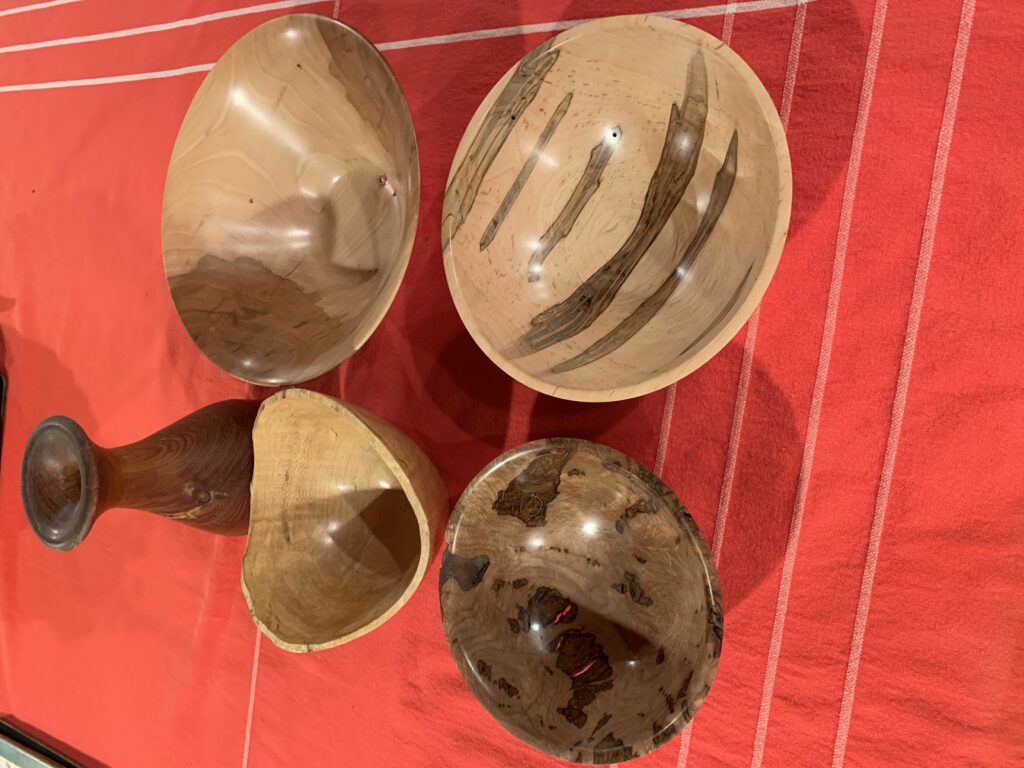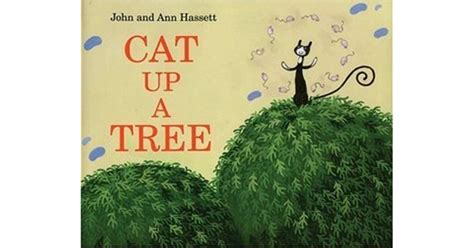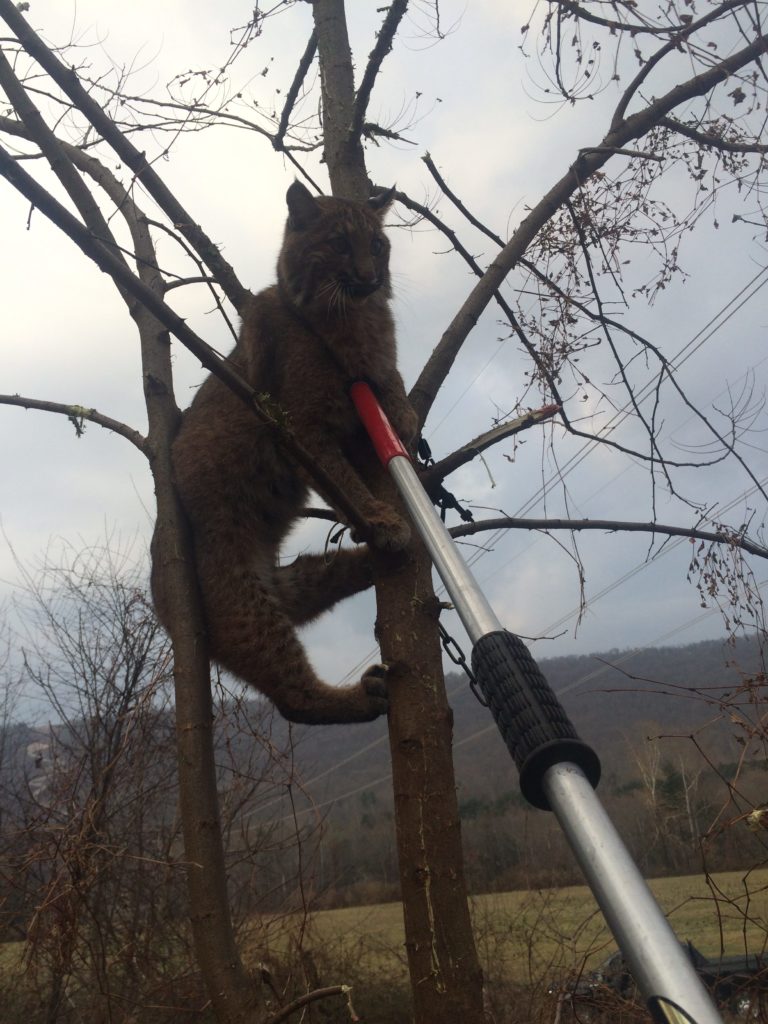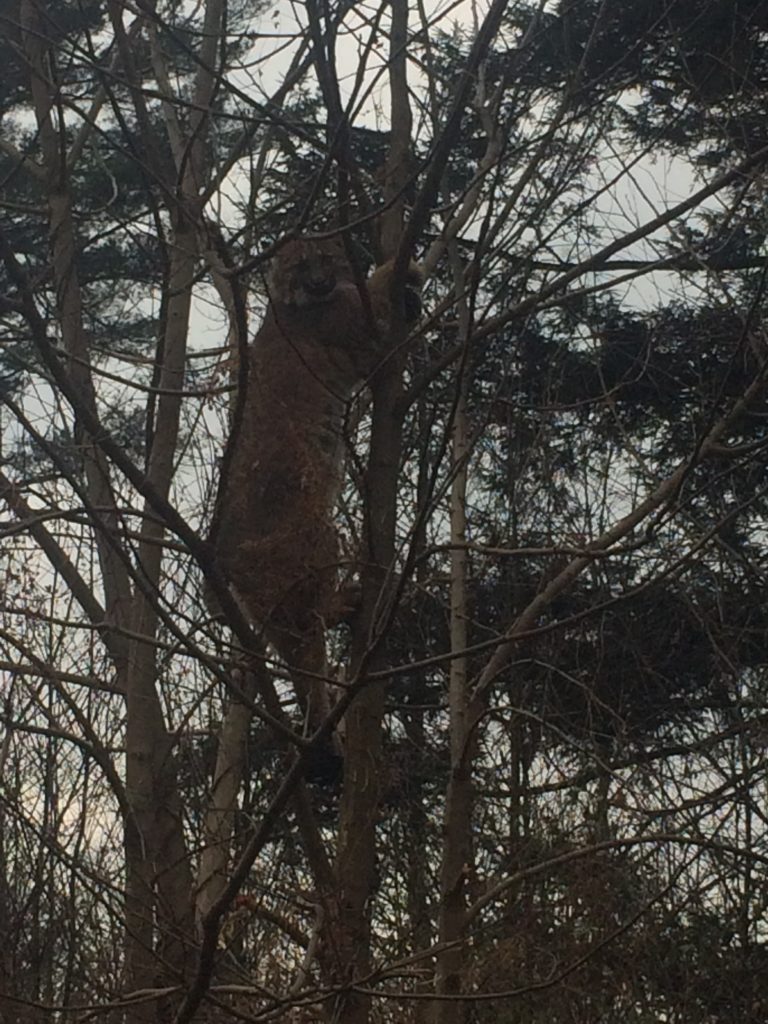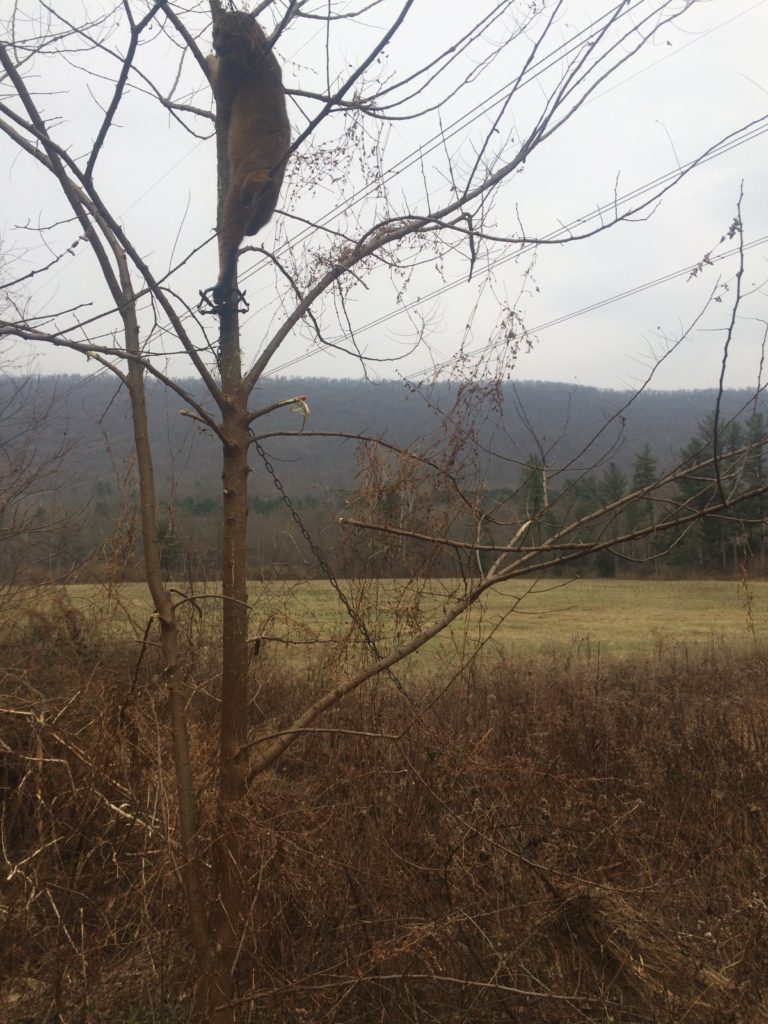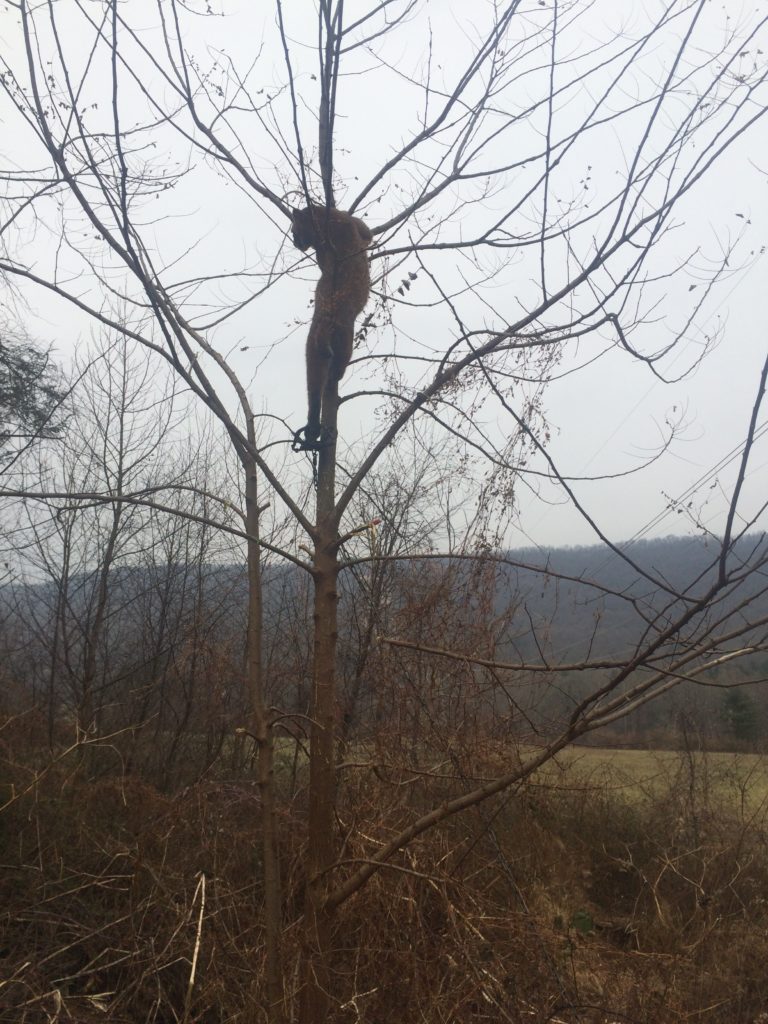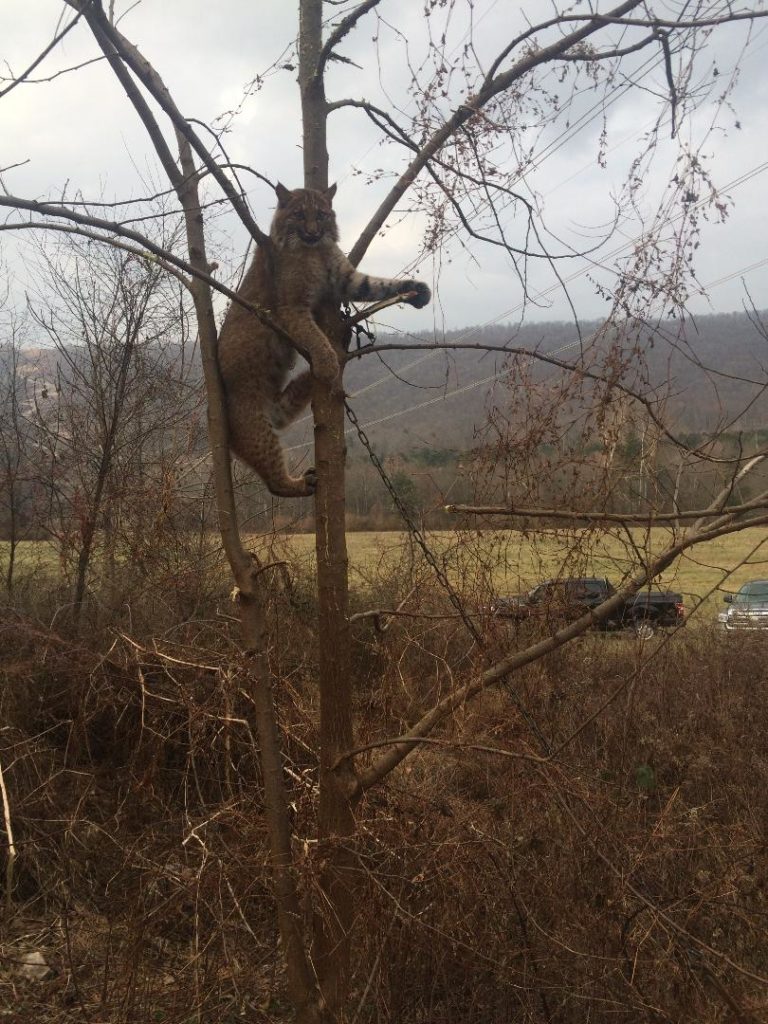Posts Tagged → tree
Is sitting in a box actually hunting?
Hunting season is cold, and getting outside to seek deer or bear or really any other wild game animal requires a person to put up with some level of discomfort. You can put a lot of effort into hunting, and still come up empty handed. So to up the odds of escaping the attention of deer and bear, some hunters created hunting blinds up in trees. The least difficult ones were railroad sikes driven into a tree to be used as a ladder, and we would hoist ourselves up onto a stout lower limb, and there wait for a shot at a passing deer.
The truly old tree blinds from the 1930s and 1940s were ridiculously frail, made of random assortments of surplus lumber; practically death traps as soon as they were nailed up to living trees. The better old fashioned tree stands would usually be put on what we called an “Indian tree,” where someone a long time ago had deliberately bent over and caused a tree to grow parallel with the ground.
When the horizontal bent limb was at least a foot in diameter, enterprising hunters would find creative ways to attach a stable platform, usually reached by a dangerous rickety wooden ladder made out of woods trash and nails. Platforms ranged from plywood to rough cut boards, some with railings and tattered old olive drab canvas and maybe a stool. Deluxe versions had some sort of roof or covering to keep rain, snow, and sunshine off of the hunter. These elevated hunting blinds were usually eight to ten feet up off the ground, and if the rickety blind did not fall down and kill you, the hunter, then you could usually use it to kill a deer. Despite requiring skill just to stay in them, these blinds were always in demand, and elders got first dibs.
Here I am talking about the American Northeast, and Pennsylvania, specifically. Not about India, where the elevated machan gave hunters of dangerous game not only an opportunity to shoot before being detected by tigers and leopards, but a chance to get in at least one more shot or even a stabbing blow with a spear before the claws and fangs were at your throat.
Fast forward fifty years, and now elevated blinds are everywhere. But they are not like the old rickety kinds jimmied onto trees with long spikes us older guys fondly recall. Witness the rise of the elevated box blinds, which are light years ahead of the rickety wooden tree stands in use when I was a kid. These new ones look like Martian landers, and are sold along the side of RT. 15 from Duncannon to Williamsport, as well as anywhere farm machinery and grains are sold, or even in Amish farm yards.
These modern elevated hunting blinds are airtight, have windows that open and close, and safe ladders or steps made of treated lumber of metal. They are downright sophisticated, and one farm lease I know of has propane heaters in all of their elevated “huts” where guys literally cook their breakfast while waiting for a deer to show up out one of the sliding windows. Some of them are big enough to hold a whole family, and indeed these are like little remote hunting cabin outposts, where everyone from Pap to the youngest kids can comfortably take a poke at a deer from a steady rest with plenty of quiet encouragement around them.
The question is, Is this elevated box blind business actually hunting?
My four-plus-inch-thick 1987 Random House Dictionary (the resilient if lonely, unknown cornerstone of our written culture) says Hunt: To chase or search for game or other wild animals for the purpose of catching or killing.
How much chasing or searching do you see going on from the ubiquitous elevated box blinds?
Not a lot. Well, none. Shouldn’t hunting involve actual pursuit and physical exertion? Don’t we need to earn our kills?
Go on YouTube or Rumble, and you can watch hundreds of “hunting” videos of hunters sitting in elevated box blinds, overlooking crop fields and power lines. These hunters usually have a long period of self-discussion to their camera about what they are looking for, any shots taken and misses they have had, etc. They have tripods and bipods, heaters, shelves with food, windows, and are generally protected from the punishing elements that mark hunting season.
The most dispiriting of this video genre has little kids holding forth, as if experienced adults, about the relative merits of various bucks caught on cell camera trail cams that very morning, and whether or not any of them are good enough for our young camerman.
And so I think we have to ask if this elevated box blind is not really hunting, then is it good for hunting? If maintained as a hunting method after their first one or two confidence building kills, the little kids are for sure being ruined by this stuff. Because it is not reality.
People who think that hunting season solely involves sitting in one spot all day, especially an enclosed and elevated spot, and then stiffly climbing down to either bitch about the lack of deer or worse, to boast about one’s prowess whacking “the big one“, are not hunters. They are shooters. If they have at all practiced target shooting before season, and they have some huge Hubble Telescope mounted on their Million Magnum Blastem Rifle, then surely they can make that three hundred yard shot on some unsuspecting deer eating dinner in a crop field.
Sorry to be negative about this, but we are losing our souls to these elevated blinds. Yes, they make hunting season more comfortable, and they make ambushing and surprising our quarry easier, but they are really dumbing down and whittling off our hunting instincts and skills, our woodcraft that separates us from the flatlander slobs who have no self reliance abilities. Hunting is not supposed to be easy, or comfortable, it is supposed to test us and make us earn the trophies we kill.
In Europe and Asia, hunting was used until the 1800s by warriors to hone their combat skills. Nothing like dismounting your horse to face off at ground level with a mean 4,000 pound Gaur or a ferocious 1,000 pound wild boar, armed with a stout spear in hand and a short sword at your hip. Back then, hunters were tough. As were our own American Longhunters on our frontier.
You want to actually hunt? Go do a deer drive like the BNB Outdoors kids, or with The Hunting Public guys. Or take a quiet, slow still hunt woods walk like John does at Leatherwood Outdoors. These hunts take skill and effort, which is the heart and soul of the chase. Everything else is just a hands-on video game at this point. No thanks.

A deer taken while still hunting two weeks ago, with open sights. Don’t look too closely, it was hit between the eyes.
This hemlock log shows climate change
Climate change has been a normal and natural fact of life on Planet Earth since the planet was created. Volcanoes explode and the earth warms up as a result. Glaciers that build up covered entire mountain ranges underneath, then recede and create new mountain ranges, then melt again, and their flood waters created new rivers, several times. Pennsylvania’s Pine Creek in the “PA Grand Canyon” used to flow north into the Genesee River watershed, until a huge ice dam from the last glacial period melted, broke, and caused an enormous torrent of water to flood southward. In that brief moment about ten or twelve thousand years ago, naturally occurring climate change forced Pine Creek to flow south, where it has become a major tributary to the West Branch of the Susquehanna River.
Climate alarmism is quite another thing, a false thing, a made-up thing, a silly thing, a destructive thing, and it is ruining a basic scientific fact that should be easy to study and understand.
Climate alarmism is where political activists falsely claim that “scientists agree that humans are causing Planet Earth’s climate to change” and that all Americans and Europeans (not the Chinese or the Indians) must therefore make drastic changes to our lifestyles, to our diets, to our freedoms. This is a fake emergency, a fake crisis, designed to help political activists get political outcomes they can not otherwise get through the democratic voting process where informed voters choose elected officials and policy positions themselves.
To illustrate how climate change naturally occurs all on its own, I took a picture and posted it here. Below is a picture I took of a roughly 160-year-old hemlock tree that a logger I work with cut down in Clinton County, PA, a month ago. If we look at the growth rings in the base of this tree, we see clusters of rings that are very wide, where the tree grew a lot in one growing season (April – September), and we see clusters of rings where the tree grew very little in one season. What is really interesting about looking at tree growth rings is that we can easily understand the climate surrounding that tree at the time of each growth ring.
Wide growth rings are associated with both an open forest canopy and lots of sunlight reaching the tree, and also with years of plenty of rain and warm temperatures conducive to plant growth after the canopy has grown up and over.
Thin or narrow growth rings are associated with a dramatic lack of sunlight, a lack of water, and/ or colder temperatures.
As we can see from this picture, this 160-year-old tree has experienced several major climate shifts over its lifetime. Each colored box is a clump of similar growth rings, which represents a period of about ten to twenty years. See how this tree went for a decade or two subject to long stretches of either very wet and warm climate, or very dry and cold climate? And we know that this tree’s life experience was largely outside of the period where the climate alarmists say humans have had the greatest influence on climate.
This tree’s life, as we see it in its growth rings, clearly shows that northcentral Pennsylvania’s climate has naturally fluctuated on its own, with no meaningful human intervention, for a long time. The picture also shows that within periods of intense dryness, there were single years of abundant rain, and then the dryness returned for years.
Today, climate alarmists seize upon every dry spell, every rainy period, every storm, to falsely claim evidence of human-caused “climate change.” If what the climate alarmists say is true, then this poor tree has had both a schizophrenic life in a natural world where equilibrium is more the natural rule, and it also experienced a lot of human caused climate change while the planet had very few humans on it to affect the climate.
In other words, this tree shows that the climate alarmists are wrong. Really wrong. The trees don’t lie, but the political activists do lie. And that fact is alarming to me.
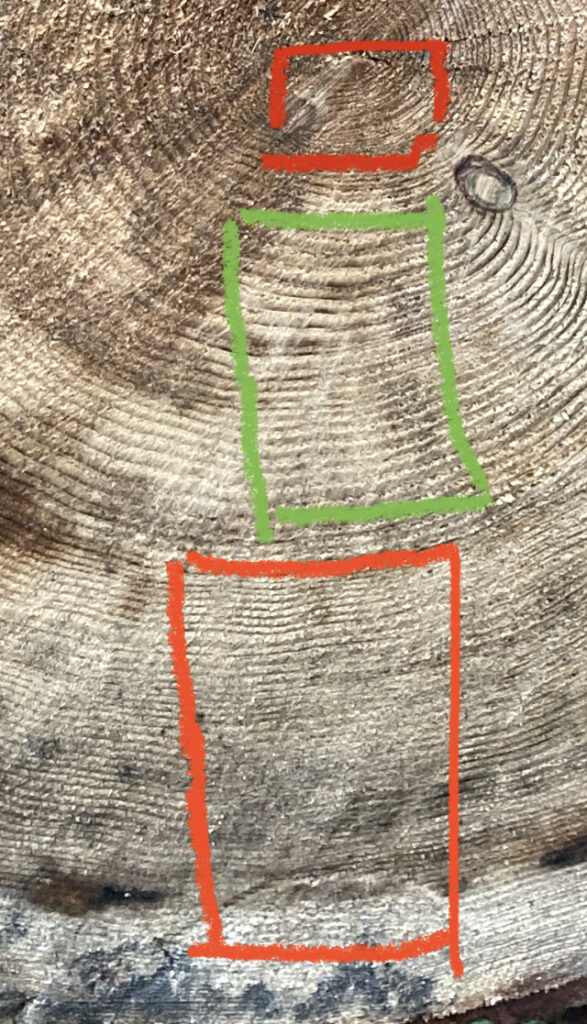
Hemlock log cut in July 2023, in Clinton County, PA. This tree has experienced widely varying climates over its long lifetime, especially while there were very few humans on Planet Earth. There is no such thing as human caused climate change. Environmental damage, yes, of course, but not climate change. Climate alarmism is a political claim, not a scientific claim.
The beautiful power of a free market guitar
A lot of the recent discussion and reporting about the World Economic Forum in Davos, Switzerland, is how hard the participants there are trying to centralize decision making, to aggregate power into as few hands as possible, and to control the choices that individual people have available to them all around the world. This effort to concentrate power and decision making in the hands of elites runs opposite and directly against the democratic forms of government that many people around the globe have fought and died to achieve.
Places like India, France, Britain, Israel, South Korea, Sweden, Norway, Germany, Austria, Italy, Hungary, the Philippines, and of course my home country of America, have all offered their citizens a maximum amount of personal freedom and opportunity. People living there can make all kinds of choices about what they want to read, to say, to wear, to eat, what kind of job they want to try, what kinds of products they want to try and create and sell. And that last part, the creating and selling part, is really at the heart of democracy. Because free markets offer choices not just in economic spheres, but which naturally blend into our own personal lives.
When a person, you the reader here, for instance, feels personally fulfilled by fully following your natural talent and curiosity, and by fulfilling your creative spirit, often also followed by greatly improving your physical living conditions, then you become a maximally happy person. This pursuit of happiness is one of the main reasons that America exists, and it is enshrined in our Declaration of Independence. A nation filled with happy people is a miracle, because it is so rare in human history. So we see that free markets create the most happy, most fulfilled individuals, who are creative, educated, and opinionated.
And we also see with the WEF that the wealthiest people on Planet Earth are now scheming and trying to take that happiness away. The WEF people do not want “little people” individuals to make their own decisions. Instead, they want centralized decision making for all of us, by a very small number of ultra wealthy people. They do not support democracy or free choice or you having an opinion that threatens their power.
I want to share a neat related video with you. To me it is powerful because it touches on this subject of an individual who follows his dream to make the best guitars possible within the free markets that the world allows. He succeeds within the international guitar market, but because of a natural resource constraint – the almost complete loss of ebony trees, necessary for making guitar necks and frets – he takes a big risk, makes some big sacrifices, and ends up playing an even bigger and more positive role in the world.
Bob Taylor, of Taylor Guitars, uses careful market-driven management of rare ebony trees and their surrounding forests to create the conditions necessary for conserving the vast African rainforest jungle those trees grow in. When the local people no longer need to poach ebony trees to sell on the black market, they become protectors of the ebony trees. Economics and free markets keep ebony trees alive, and growing for the future, as well as the richly diverse jungle habitat in which ebony trees grow. This is powerful stuff only achievable by free markets.
The same dynamic is also at play with trophy hunting in Africa, where wealthy hunters pay much more to kill wild game than that same animal is worth as bush meat to the local populations. Because the locals get the meat from the trophy animal (99% of the trophy animal is immediately donated to locals, the hunter and the safari camp getting the other 1%) anyhow, and they also get the hunting and tourism-related jobs from the international visitors who want to see and hunt wildlife, the incentive shifts away from poaching and market hunting to the locals then protecting and conserving the wild game they once saw only as a meal. Again, powerful natural resource conservation as a direct result of free markets.
Long live free markets, personal choice, personal accountability, and personal reward for hard work and risk taking. May the World Economic Forum fail in its effort to end our choices and to make us “own nothing.”
Here is the Taylor Guitar video. I hope it speaks to you like it speaks to me.
(and here is the ten years later video, which is about ebony tree planting and husbandry)
Rockville’s big tree
Every year over the past ten years around Christmas a family in the Rockville neighborhood north of Harrisburg has put up a beautiful light array on their yard tree.
It’s now so pretty that people come from all around to admire it. It’s one of those small local things that brings a community together. I like sharing it here.
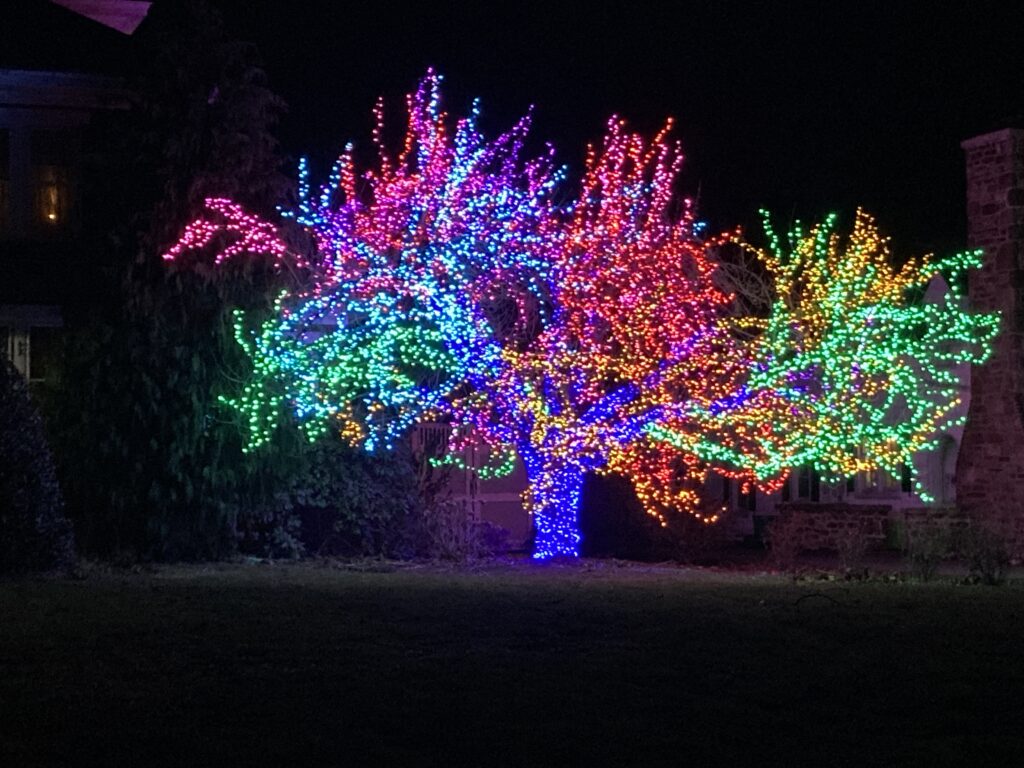
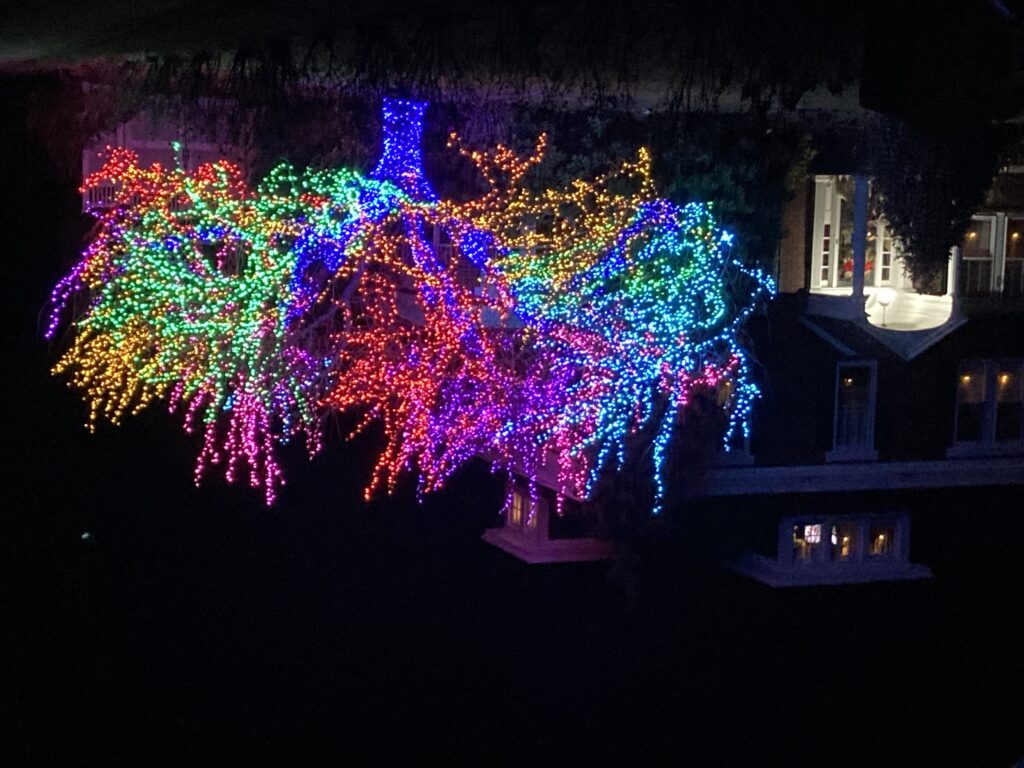
PA’s Forester Jim Finley Enters the Forest Cathedral
Penn State forestry professor emeritus, department head, and all-things-forestry guru Jim Finley died yesterday. I was told that he was either felling a large tree on his property, or he was trying to dislodge a large tree that had been felled but was hung up on another tree. Whatever the actual facts are, Jim died from the tree falling on him. It is a reminder that even the best, most experienced forestry professionals are at grave risk.
As trite and awkward as it sounds to write here, the fact is that Jim Finley died doing what he loved in the environment he considered sacred. I am quite sure that had he been asked about whether he would like to die from a tree falling on him, or some more peaceful and less traumatic way, he would have given us the look he is giving below. It is that knowing “Why are you saying that, you know it is wrong” look. In his mid-70s, Jim was nowhere ready to leave us, and we were nowhere ready to let go of him.
His death is a huge loss.
Jim was a remarkable man, who I admired, and who left a way outsized hand print on Pennsylvania conservation and the practice of forestry in eastern America. He was a force to be reckoned with, an institution in his own right, a political-cultural movement, a gentle soul with a will of iron, kind and easy but also passionate and unrelenting.
He did not suffer fools easily, though he accepted honest debate and earnest dissent exactly the way an academic ought to: His eyes took on this hard laser focus, and you could tell he was actively listening and processing, not always ready to give an answer, either. His response might come tomorrow or next year, and if your argument was good, you could tell it had moderated Jim’s perspective.
Jim Finley was an academic, and sometimes prone to the idealism that academics naturally grow into. However, he also had the ability to be hands-on practical, and even more important, he had the ability to support aggressive, hands-on, totally practical forestry practices. You know, the kinds of visual impacts that most urbanites recoil in horror from, and which many land conservation groups really did not want to see, either, no matter how scientifically they were needed or justified. It is an admirable and rare trait to be able to be honest about unpleasant things, and Jim could look at a heavily cut tract with tree tops lying all over the place, and cheerfully explain all of the wonderful things that were now going to follow on the heels of all that disturbance. Because of Jim, conservation easements in Pennsylvania are now a lot more forestry-friendly than they used to be. And a landowner who is able to manage his or her forest as aggressively as they need to under a conservation easement, is a landowner who is much more likely to sign that easement and protect their land in the first place.
Jim invited me to speak to his classes a couple of times, and we worked together when I was at DCNR and the Conservation Fund. I knew him when I was a kid in State College, I knew him as a professional forester and academic at Penn State, and I knew him as a colleague of land conservation legend and Penn State forester Joe Ibberson, whose PSU forestry department endowment Jim presided over at the end of his formal career. It is always a huge loss when someone of Jim’s high caliber leaves us, but it is even more so when he was just starting to become mature, as he would put it in the terms of a tree.
So long, old friend. Happy travels in your peaceful forest cathedral. We who are left behind mourn your untimely departure and we will miss you greatly. You were a hell of a guy, Jim.
This day a year ago while trapping: Cat up a tree!
Cat Up a Tree!
Text and Photos by Josh First (copyrighted)
I dislike trapping in rainy conditions, because it is uncomfortable, messy, and technically difficult, due to trap sets needing constant fixing up; and I really dislike processing muddy critters. Mud-covered fur is time consuming, and usually it is not worth it in my tight schedule. So from 2018’s trapping season opening day in late October, I waited six weeks, until a brief rain lull in mid-December, to put out some carefully planned traps.
Though I was aiming mostly for canids like fox and coyote, both bobcat and fisher were a reasonable hope. I have caught bobcats in and out of season in the past, but never a fisher. These are two neat animals worth working hard for, and each of which will quite willingly enter baited cubbies where foot hold traps can get some shelter from rain and snow.
So on the Wednesday afternoon before that Saturday bobcat and fisher opener, a half-dozen footholds (cubbies and flat sets) and a few large cage traps were set in strategic places near where I had seen fisher tracks or bobcats across a 100-acre area of mixed farmland and woods in Dauphin County. Bait is used in the cage traps to pull in the inevitable and limitless possums, skunks, and raccoons, so that, hopefully, only the cool critters find the footholds. And both bobcats and fishers will enter cage traps, so they do serve double duty.
One pass-through pee post set was put in a location where I have previously caught coyotes, foxes, and raccoons. It is at a corner of a dirt farm road, a woods road, a hay field, and brushy-hedged crop field where heavy woods meets an active agricultural area. Just about every local furbearer walks the brushy area, this road, and the field edges leading to it.
Coyote pee and coyote gland lure were put on top of a two-inch-thick dry pine limb sticking up 14 inches, placed at the seam where the goldenrod meets the farm road. A few pieces of goldenrod stem on the other side created the pass-through effect, so the animal’s body would line up with the hidden trap just exactly so. About eight inches away from the post an offset MB 550 attached to an eight-foot heavy chain linked to a heavy two-prong coyote drag was bedded level atop soft goldenrod tops to protect the trap from freezing to the wet dirt underneath, then covered judiciously in waxed dirt, then finished with more soft goldenrod tops and weed tips blended on top. The trap was perfectly “blended in” and hidden from sight.
The chain was stretched out away, into the reverting goldenrod field, and well covered and camouflaged with weeds, and the rusty-brown colored steel drag itself unobtrusively hooked into the dirt. With four heavy swivels well spaced between the trap and the drag, I felt confident that whatever would step on the trap pan while passing between the weeds to smell the pee post would commit its full weight, and be safely held fast, no matter where it went afterwards. I expected the animal to head directly to the nearby brushy hedges, where the grapple and chain would immediately become entangled, thereby holding the animal for the next 24-hour trap check.
Usually predators take a couple days to fully investigate my traps, and when setting this on a late Wednesday, I anticipated catching something in one of the sets on Friday night/ early Saturday morning. Though aiming for a bobcat, fox, coyote, or fisher, the truth is I had put off trapping so long that season that I would have been happy to catch just about anything.
The next day, Thursday, I did a cursory trap circuit check in my truck, looking out the window while driving past set after set. “No…No…No…footprints all around but no step on the pan…no…no…nothing” as I went by each trap location.
Pulling up to the pee post set, my eye was immediately drawn to the pee post itself lying on the ground, though the trap bed itself did not appear disturbed. Usually the post is knocked over by the chain after an animal has stepped on the trap and fled. So I got out to check, and was not surprised to see the drag gone. Following an obvious path of bent weeds and scuffed dirt leading away towards the closest brushy forest edge, my eyes naturally looked along that edge for a hung-up drag and critter.
With my hands on my hips, I stood and kept scanning the brushy woods-field edge. I was unable to locate anything, and felt mystified about how the critter could have escaped beyond such a thick, natural entanglement area. Mystery remained until a hiss to my right reached my ear, steering my eyes in that direction.
“Why is that long-legged grey fox up in that honey locust like that?” was my first thought.
Then another thought followed the first: “Why does that grey fox look like a big cat?”
And then the bobcat came into focus. It was a nice sized young male, probably 25 pounds, about six feet up in a young honey locust, a tree that has plenty of sharp thorns and very hard wood. The drag was just touching the ground, and the chain was wound about the lowest branches.
OK, I thought, I’ll have this resolved in a few minutes. Seemed like no big deal to pull down the cat, use the catch pole to hold it steady while I released the trap from its foot and let it go unharmed.
Fast forward an hour, and each time I had tried different ways to bring it down out of the tree unharmed, the cat had moved farther up. With bobcat season two days away, by law the cat had to be released, but I was unsuccessful with each solution I tried.
Fretting and scratched by the locust thorns, I left, did some work, and returned a few hours later, hoping the cat had climbed down and was entangled in the ground brush nearby. On the ground it would be easy to release using a catch pole. Easier than up that tree!
But when I got back, the bobcat was still up the tree, and climbed yet higher as I approached it.
Time for Plan B, which is where I admit that I need help. Usually takes me a long, long time to implement Plan B, and so I called the Pennsylvania Game Commission southeastern regional office. At first the dispatcher congratulated me on catching the bobcat, but then moments later expressed his sympathy for me having to release such a fine trophy, as the season was yet to begin. He forwarded my message to a local Game Warden, who then fairly quickly met me right at the honey locust. In fact, he arrived so quickly that I could not help but wonder if he had been watching me the whole time, either chuckling at my clumsy efforts, or waiting to see what else I might do, or both.
“Thank you for coming. When my kids were little, their favorite book was Cat Up a Tree! And here it is in real life. Should we call the fire department?” I said to Game Warden Scott Frederick, half-jokingly. In that colorful book, the fire department saves the day by saving the cat stuck up in the tree, and we (and how I so liked the ‘we’ part) did indeed have a daggone cat way up in a tree. But unlike the book, we had no long ladders, or hero firemen, by the honey locust tree that day.
I asked my wife to film our escapade, but under questioning I revealed that pretty much anything could happen to anybody around this, so she said something like “No, I’m not recording two idiot men playing with matches.” I think her imagination had the warden and I emerging from the dense, high brush scratched head to toe, our clothes in ragged tatters, like some cartoon involving the Looney Tunes Tasmanian Devil. She wanted no part of it. This is why women live longer than men.
Warden Frederick tried to the untangle the chain and reach the animal, but with each new inch of loose chain, the bobcat sensed freedom and used the slack to climb ever higher. Upon reaching a tight chain again, he would stop his ascent, alternating between hissing at us and letting fly with whatever he could rustle up in his bowels. I came to learn that bobcats have an impressive amount and array of bad smells stored inside them. Neither Warden Frederick nor I smelled peachy at that point, but I gave in and laughed at him when he really got it good from the cat.
Eventually we had tried and tried every which way to get the cat down unharmed, the day waxed late, and so we decided that if the cat would not come down, then the tree had to come down.
A honey locust is a hard, tough tree, a pioneer species with twisting grain and sharp hooked thorns. Oftimes while being sawed, they don’t fall the way you think they will. In addition to its loud scary noise, a chain saw would remove too much wood too quickly to allow us to fully control which way the tree would fall, and a hand saw was too slow. So we used an axe to drop the tree, one carefully placed chop at a time. This gave us the best control over the tree’s slow descent, but it was sweaty work, and directly beneath the bobcat. So I let Warden Frederick do it.
Meanwhile, the bobcat climbed to the very top of the tree, clinging like a lookout in a ship’s crow’s nest, and swayed to the rhythm of the chop-chop-chop below.
As the tree gave way to the axe and slowly sank to the ground, the bobcat sensed its getaway approaching. But Warden Frederick was waiting with a catch pole. While I wish I had some humorous Game News Field Note material here to describe what happened next, the truth is Warden Frederick properly and quickly looped the bobcat’s shoulder and neck, under the armpit, thereby safely pinning the animal to the ground without risk to its esophagus (cats have really weak throat areas and they must be handled carefully). I got some last quick photos, threw a blanket over the bobcat to calm him down (the bobcat, not Warden Frederick), and then easily pulled the trap off of its foot.
Both of us inspected its foot and leg for damage, and seeing none, I stepped back, pulled the blanket, and the catch pole loop came off the bobcat. As many other trappers have experienced when releasing a trapped bobcat, this one sat on its haunches and hissed at us. He thought he was still stuck. Eventually he turned and fast- walked into the brush.
“Well, that’s it, I’m now officially jinxed, or ‘lynxed’,” I said to Warden Frederick. “From here on out I will catch only possums and skunks for the rest of the season.”
And in fact, for the rest of that epic rainy trapping season, such as it was, I caught a grand total of just five possums, one skunk, and one raccoon. It was my worst trapping season, numbers-wise, in many years. But in hindsight, it was also pretty rewarding to watch the Game Warden work like that. Both hard and smart, I mean. Citizens don’t get to see our public servants perform these kinds of feats very often, and with a good nature to boot. So in that sense, I had a uniquely good season. Thank you, Warden Frederick. Now I can’t wait for mountain lions to move into Pennsylvania!
[Why do I trap? I trap to save ducklings, goslings, baby songbirds, nesting grouse, woodcock, and turkeys from an endless number of ground predators like skunks, possums, raccoons, foxes and coyotes, all of which continue to pulse out from suburban sprawl habitats in artificially high numbers. These artificially high numbers of predators do tremendous damage to ground nesting birds, and basically cars and trappers are their sole adversaries. So if you are against trapping, you must hate cute little ducklings. Foothold traps do not crush bones or kill animals, they simply hold them, and as we can and did here, animals can be released from footholds totally unhurt]
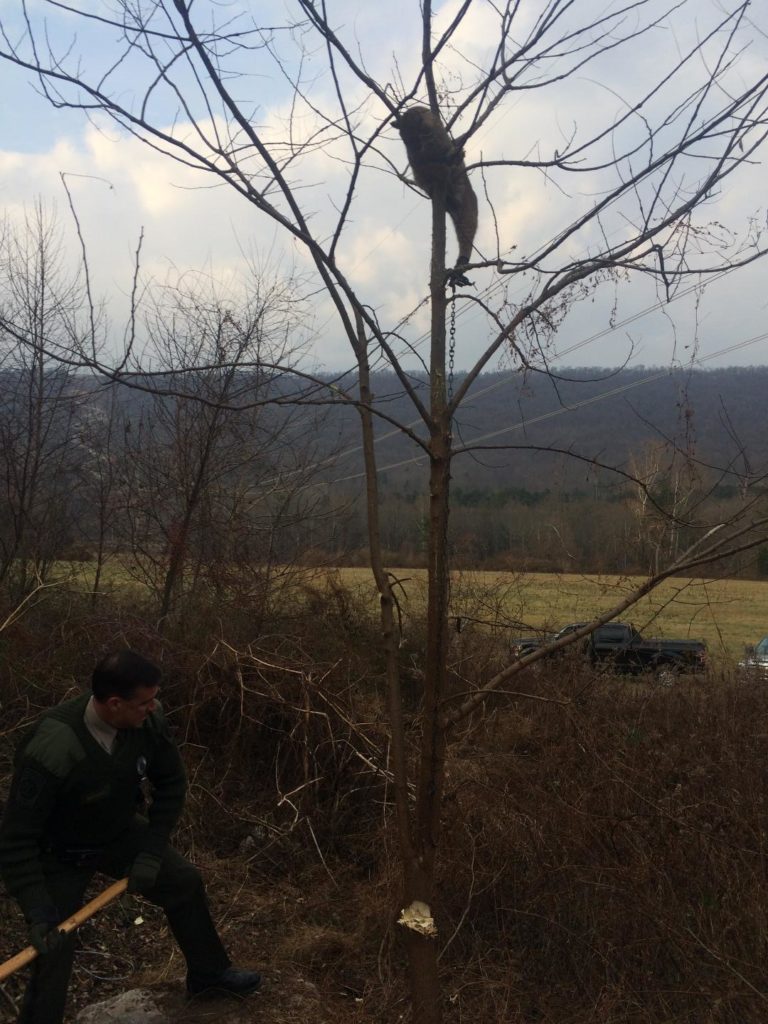
If you ever want to feel like you are getting your tax money’s worth, look closely at this photo of PA Game Warden Frederick chopping at that honey locust. Except that the PA Game Commission operates on hunting license fees, timber sales, and natural gas leases! No tax money goes to the PGC, and yet they provide so many taxpayer services.
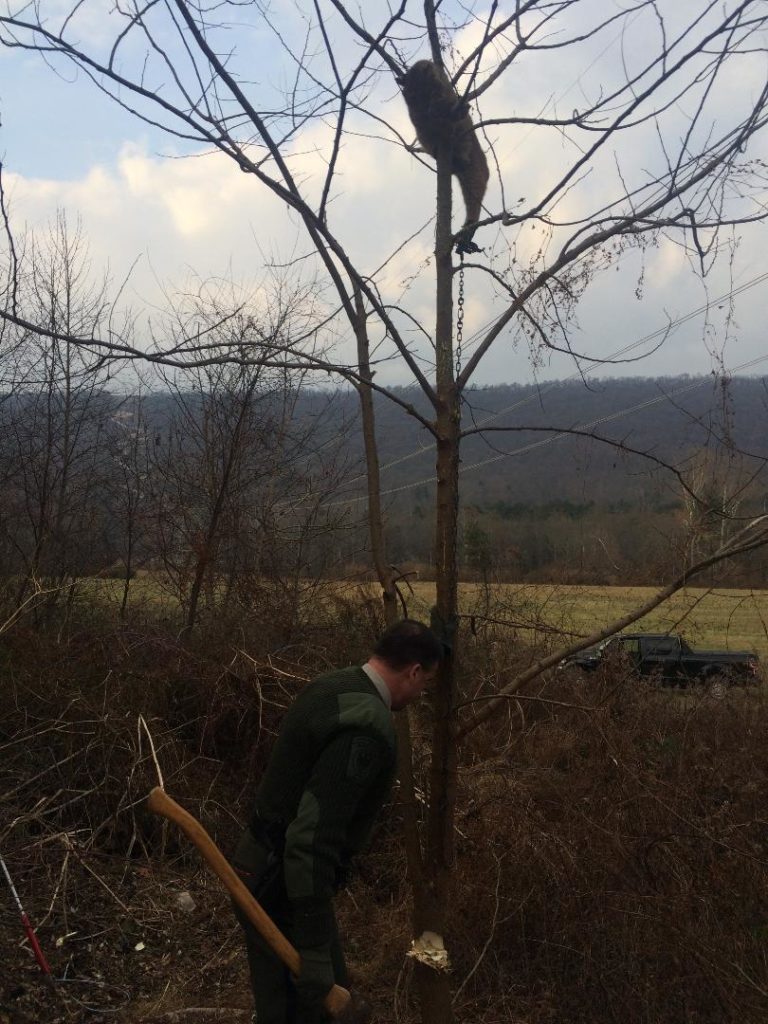
The four swivels and the long chain are visible here. The swivels prevent the chain from binding as the animal moves around, which gives the animal complete 360 degree movement. This is important so the animal does not torque its leg or hurt itself trying to get free. The long chain is needed to get hung up quickly in brush
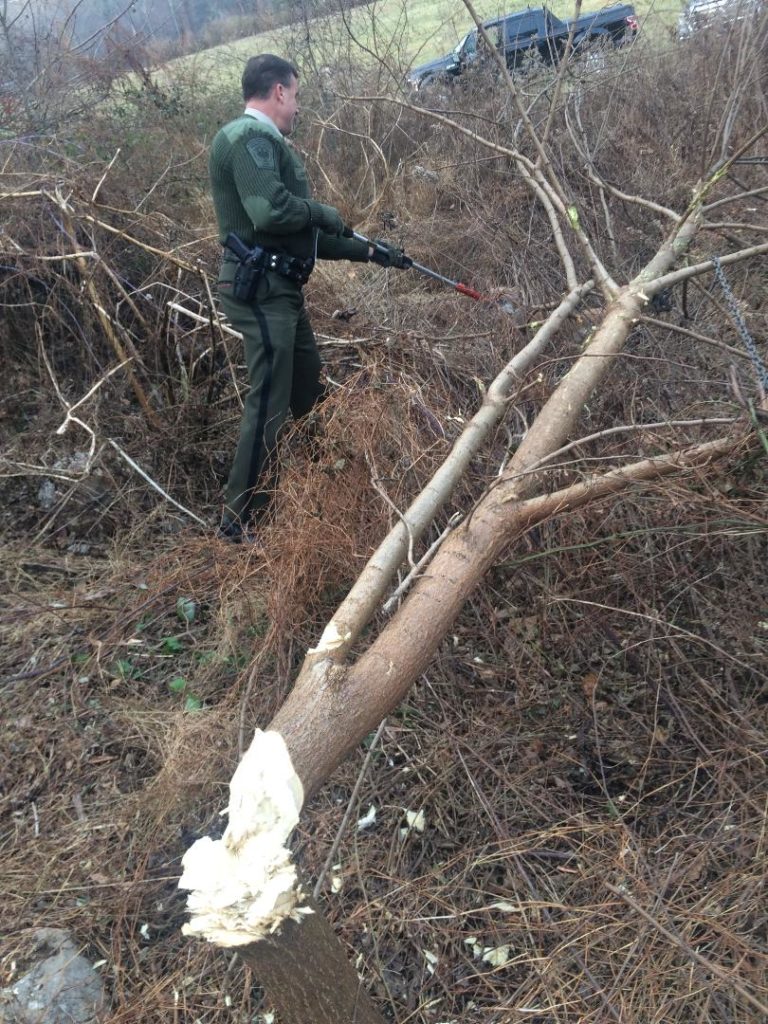
The unharmed bobcat can be seen hissing at Scott, who has the catch pole loop around its upper body, pinning it to the ground. After taking this picture, I threw a blanket (Scott’s, not mine) over it to calm it down, inspected its leg for any damage, and when we each determined the animal was not hurt, Scott then released it. Using a catch pole on a bobcat requires getting the loop under its armpit and around the neck, so the esophagus is not damaged.
Hunting licenses, 1976 and 2015
Since my first hunting license adorned my back way back in 1976-1977, a lot has changed in the Pennsylvania landscape.
For example, wild game then so abundant that you could go out and shoot a couple for dinner is now practically extirpated.
Why pheasants and quail disappeared from Pennsylvania is a big debate with no clear answers. Loss of farmland to sprawl, low density development is one. Changes in farming practices is another; fallow fields had the best habitat. A plethora of winged and four legged predators cannot be discounted. Successfully rebounding populations of raptors like hawks and owls for sure ate a lot of plump pheasants. But why a sudden and dramatic crash?
Conservation successes since 1976 are plentiful and say a lot about wildlife biology. Wild turkey populations, fishers, bobcats and other animals once thought completely gone are now firmly in our lives, whether we see them, or not.
An interesting dynamic is playing out at our hunting camp. This year we have a virtual carpet of oak and hickory seedlings unlike anything we saw over the past 15 years we’ve owned it. Why?
Conventional wisdom is the deer population is low, and it’s true that it’s lower than it has been in 15 years. That is, deer are known eaters of acorns and tree seedlings. Fewer deer means more of both.
However, another factor seems to be playing out with these newly abundant tree seedlings. Where we once had an incredible overload of tree rats, aka squirrels, the new fishers have eaten them all. Like all of them. Not one tree rat remains in our carefully cultivated forest of white oaks. We see fisher tracks. We neither see nor hear squirrels.
As squirrels are known eaters of acorns and hickories, it stands to reason that their absence means more acorns and hickories hatching into baby trees.
Add a long icy winter that appears to have crushed our local wild turkey populations, also known for eating nuts, and the right conditions emerge to help a forest rebound and grow some new stock, a huge challenge we aggressively tackle every year.
So, my son getting his first hunting license yesterday is now entering a landscape that in some ways is just as dynamic as the one I began hunting so long ago. What a difference these landscapes were and are, and who would’ve guessed the fishers would be responsible for oak and hickory forests regenerating?
A lot has changed in our wildlife landscapes, and yet not much has changed in my lifetime. Different animals, same kind of population changes, variations, pressures. One thing I keep reminding myself: It’s all natural, these changes. And while some are painful to see, like the loss of pheasants, other opportunities open up. Never would I have imagined in 1976, nor would any PA Game Commission staff, that in 2015 my son would get a bobcat tag and a fisher tag with his license.
Totally different opportunity than chasing pheasants in corn fields, but still good.
Aggressive timber management necessary in the Northeast
When I tell some people how aggressively we try to manage standing timber (forests), they often recoil. It sounds so destructive, so environmentally wrong.
It is not environmentally damaging, but I will be the first to admit that the weeks and months after a logging operation often look like hell on the landscape: Tops everywhere, exposed dirt, skid trails, a tangled mess where an open woods had stood for the past sixty to eighty years just weeks before. No question, it is not the serene scene we all enjoyed beforehand.
This “clearcutting” gets a bad name from poor forestry practices out West and because of urban and suburban lawn aesthetics being misapplied to dynamic natural forests.
However, if we do not aggressively manage the forest, and the tree canopy above it, then we end up with tree species like black birch and red maple as the dominant trees in what should be, what otherwise would be a diverse and food-producing environment. Non-native and fire-sensitive species like ailanthus are quickly becoming a problem, as well.
When natural forest fires swept through our northeastern forests up until 100 years ago, these fire-sensitive species (black birch, red maple) were killed off, and nut trees like oaks, hickories, and chestnuts thrived. Animals like bears, deer, turkey, Allegheny woodrats, and every other critter under the sun survived on those nut crops every fall.
Without natural fire, which is obviously potentially destructive and scary, we must either set small prescribed fires, or aggressively remove the overhead tree canopy to get sufficient sunlight onto the forest floor to pop, open, and regenerate the next generation of native trees. Deer enjoy browsing young tree sprouts, so those tasty oaks, hickories, etc that lack sufficient sunlight to grow quickly usually become stunted shrubs, at best, due to constant deer nibbling. Sunlight is the key here.
And there is no way to get enough sunlight onto the forest floor and its natural seed bed without opening up the tree canopy above it. And that requires aggressive tree removal.
Northeastern forests typically have deep enough soils, sufficient rainfall, and gentle enough slopes to handle aggressive timber management. Where my disbelieving eyes have seen aggressive management go awry is out west, in the steep Rockies, where 1980s “regeneration cuts” on ancient forests had produced zero trees 25 years later. In fact, deep ravines had resulted from the flash-flooding that region is known for, and soil was being eroded into pristine waterways. So, aggressive timber management is not appropriate for all regions, all topography, or all soils.
But here in the northeast, we go out of our way to leave a huge mess behind after we log. Why? Because how things appear on their surface has nothing to do with how they perform natural functions. Those tangled tree tops provide cover for the next generation of trees and wildflowers, turtles and snakes, and help prevent soil erosion by blocking water and making it move slowly across the landscape.
Indeed, a correctly managed northeastern forest is no place for urban or suburban landscape aesthetics, which often dictate bad “select cut” methods that work against the long term health and diversity of the forest, as well as against the tax-paying landowner.
So the next time you see a forest coming down, cheer on the landowner, because they are receiving needed money to pay for the land. Cheer on the loggers and the timber buyers, the mills and manufacturing plants, and the retailers of furniture, flooring, and kitchen cabinets, because they all are part of a great chain of necessary economic activity that at its core is sustainable, renewable, natural, and quintessentially good.
Why deer hunting is good for the environment
This past week was the early muzzleloader season in Pennsylvania. Instead of the modern inline muzzleloaders, I use an old fashioned flintlock. It is more challenging, and honestly, it’s just plain beautiful to look at.
Up at a relatively small piece of land I’ve been cultivating for twelve years, this fall marked the first time I’ve seen young oak seedlings survive deer browsing. Across the forest floor a plethora of oak seedlings – white, red, chestnut – create a carpet effect that indicates a future of young oak trees….if they can avoid being eaten by deer.
While I was casually walking through the forest, I saw a young doe looking at me. I raised the gun and fired. I will take any opportunity to help the little oaks become big oaks. They do, after all, produce the acorns necessary to feed deer, bears, turkeys and many other wild animals.
Then as if on cue, one of my very next steps was right into an enormous pile of bear poop. Colored brown from all the acorns, this fresh pile represents a great modern conservation success story, Pennsylvania’s population of huge black bears.
How ironic that deer can eat the trees needed to feed both themselves and their predators, the bears. How ironic that humans, who have dramatically shaped our planet over the past 20,000 years, do all we can to help an animal that might want to eat us (the bear), due to our recreational desires, and in doing so eat the deer sought by the bear.
Life is intertwined. Our futures are intertwined, humans and wildlife. Deer hunting is good, and good for the environment.
Fifty years of designated wilderness
Two weeks ago marked the fiftieth anniversary of the signing of the Wilderness Act.
It applies to federal designation of remote areas, not to states. States can create their own wild areas, and some do. States closest to human populations and land development seem to also be most assertive about setting aside large areas for people and animals to enjoy.
I enjoy wilderness a lot. Hunting, camping, hiking, fishing, and exploring are all activities I do in designated wilderness.
Every year I hunt Upstate New York’s Adirondack Mountains, in a large designated wilderness area. Pitching a tent miles in from the trail head, the only person I see is a hunting partner. Serenity like that is tough to find unless you already live in northern Vermont, Maine, Montana, Idaho, Wyoming or Alaska. It’s a valuable thing, that tranquility.
This summer my young son sat in my lap late at night, watching shooting stars against an already unbelievably starry sky. Loons cried out all around us. A gentle breeze rustled the leaves on the birch trees above us and caused the lake to lap against our rocky shore.
Only by driving a long way north, and then canoeing on a designated wilderness lake, and camping on a designated wilderness island in that lake, were we able to find such peace and quiet. No one else was anywhere around us. We were totally alone, with our camp fires, firewood chores, fishing rods, and deep sleeps in the cold tent.
These are memories likely to make my son smile even as he ages and grapples with responsibilities and challenges of adulthood. We couldn’t do it without wilderness.
Wilderness is a touchstone for a frontier nation like America. Wilderness equals freedom of movement, freedom of action. The same sort of freedoms that instigated insurrection against the British monarchy. American frontiersmen became accustomed to individual liberty unlike anything seen in Western Civilization. They enshrined those liberties in our Constitution.
Sure, there are some frustrations associated with managing wilderness.
Out West, wilderness designation has become a politicized fight over access to valuable minerals under the ground. Access usually involves roads, and roads are the antithesis of a wild experience.
Given the large amount of publicly owned land in the West, I cannot help but wonder if there isn’t some bartering that could go on to resolve these fights. Take multiple use public land and designate it as wilderness, so other areas can responsibly yield their valuable minerals. Plenty of present day public land was once heavily logged, farmed, ranched, and mined, but those scars are long gone.
You can hike all day in a Gold Mine Creek basin and find one tiny miner’s shack from 1902. All other signs have washed away, been covered up by new layers of soil, etc. So there is precedent for taking once-used land and letting it heal to the point where we visitors would swear it is pristine.
Out East, where we have large hardwood forests, occasionally, huge valuable timber falls over in wilderness areas, and the financially hard-pressed locals could surely use the income from retrieving, milling, and selling lumber from those trees. But wilderness rules usually require such behemoths to stay where they lay, symbols of an old forest rarely seen anywhere today. They can be seen as profligate waste, I understand that. I also understand that some now-rare salamanders might only make their homes under these rotting giant logs, and nowhere else.
Seeing the yellow-on-black body of the salamander makes me think of the starry night sky filled with shooting stars. A rare thing of beauty in a world full of bustle, noise, voices, and concrete. For me, I’ll take the salamander.








